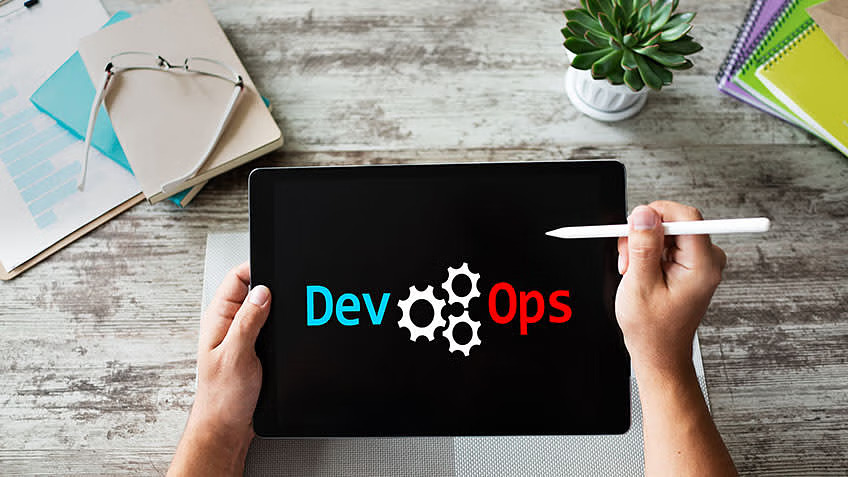DevOps has gained much traction over the past few years and is a valuable tool in app development. However, organizations must have a solid grasp of implementing DevOps most effectively. A little knowledge can ensure a smooth process and avoid pitfalls. That’s why there are DevOps best practices.
This article offers valuable insights into DevOps best practices. We begin with a refresher on what DevOps is and why it’s important, then move on to the best practices. We will also discuss DevOps anti-patterns, how data analytics trends figure into the process, and how to get certified training through an online DevOps bootcamp.
Let’s get the ball rolling with a high-level definition.
What is DevOps?
Before we dive into DevOps best practices, let’s remind ourselves what DevOps is. DevOps is a relatively new application design philosophy that helps organizations deliver high-quality, reliable software faster while facilitating adaptation to the ever-changing needs of the business and customer demands.
The term “DevOps” is a fusion of the terms “development” and “operations,” closing the gap between software developers and IT operations. DevOps combines both groups with flexible, adaptable software creation and delivery practices, tools, and cultural philosophies.
So, why is DevOps important?
Also Read: DevOps Tutorial: How to Install Docker on Ubuntu?
Why DevOps Matters
DevOps helps businesses become more efficient and responsive. Using the DevOps methodology to combine development and operations, organizations can streamline the software app creation processes and reduce the time needed to get their new products and services to the market. Successful DevOps implementation can reduce the number of mistakes and flaws in their products and services while improving reliability and scalability.
DevOps improves the organization’s effectiveness, efficiency, and overall performance, resulting in happier customers and increased competitiveness, as customers can access new features and functionalities faster.
Software and the Internet have changed how the world conducts business, from shopping to banking to entertainment. Software no longer just supports a business; it’s now also a vital component of every aspect of the business. Companies increasingly interact with their customers through software typically delivered as applications or online services run on various devices. Businesses also use software to boost operational efficiencies by making positive changes in every part of the value chain (e.g., logistics, communications, and operations).
So now that we’ve established what DevOps is and why it plays a vital role in today’s commercial world let’s explore a dozen DevOps best practices.
Best Practices for DevOps Implementation
Although we can cover many potential DevOps best practices, let’s keep things manageable and focus on the twelve most critical best practices.
Place Customer Satisfaction First
Regardless of your methodology, the goal is to meet customer expectations. DevOps allows organizations to streamline the release process of new software, services, and applications. Since the same personnel manage the release of code and write the new code, it’s simpler to roll out new functionality to the customer faster.
On the other hand, some industries may not want brand-new functionality delivered to them too often. For example, a new feature delivered in the middle of the working day will probably not benefit a professional in the thick of their job. That’s why understanding the customers in their situations and context is critical to a successful DevOps approach.
Practice Continuous Monitoring
Continuous monitoring is a critical DevOps best practice since it allows organizations to track their performances and the stability of their systems in real-time conditions. By constantly collecting and analyzing data from their development processes, organizations can spot and resolve issues faster and make better, more informed decisions about the directions of their services and products. Thus, monitoring reduces the likelihood of potential issues turning into serious problems.
Implement a Continuous Integration/Continuous Deployment (CI/CD) Pipeline
Here, we have another “continuous” practice; DevOps is all about continuous activities. Introducing a Continuous Integration/Continuous Deployment (or CI/CD for short) pipeline is the key to implementing a practical, successful DevOps philosophy. CI/CD pipelines automate the build, test, and deployment processes, allowing companies to deliver necessary code changes quickly and reliably. CI/CD pipelines also help robustly implement the “shift-to-left” concept in development processes.
Automate Routine Tasks
Automating routine tasks reduces the time and energy needed to deliver a product to the end user. When everyday tasks, such as running tests, building and deploying code, and monitoring systems, are automated, companies reduce errors, improve efficiency, and increase the reliability and scalability of their systems. These benefits ultimately reduce the cost and effort of delivery. Automation allows DevOps teams to use the newly acquired free time to focus attention on more strategic and value-added activities.
Seek Continuous Feedback
DevOps must seek continuous professional feedback from users, stakeholders, and team members. This feedback can improve the quality and importance of the organization’s products and services and can be used to identify and resolve issues or discover areas for improvement. Feedback also helps organizations nurture a culture of collaboration and continuous learning, which benefits the organization and its employees. For instance, a DevOps engineer might seek continuous feedback during code reviews. So, they conduct code reviews with other team members or stakeholders and gather feedback on the quality of their code, identify possible issues, and recommend improvements.
Set Up Automated Testing
Automated testing can help organizations improve the quality and dependability of their code. By automating the testing process, companies can cover many test cases that may otherwise be missed in manual testing. As test coverage increases, the risk of human error and bugs in production decreases, allowing more time to deploy and deliver the product without rushing the process to meet a deadline. Additionally, automated testing provides immediate feedback, letting the team focus on critical issues and strategic activities while lowering the cost of software maintenance. Also, incorporating AIOps into these automated processes can further boost efficiency and reliability.
Also Read: A DevOps Engineer Job Description for Aspiring Professionals
Integrate Continuous Security into the DevOps Process
Security is vital to all IT operations, and DevOps is no exception. Continuous security is a mix of practices and tools that increases the organization’s ability to deliver applications with no known vulnerabilities securely. Continuous security adds new tools for vulnerability scanning and secure storage and introduces testing methods such as penetration testing into the DevOps pipeline. In addition, continuous security also enforces new practices for both the developers (e.g., secure coding) and operations (such as logging and alerting).
Also, by integrating continuous security into the DevOps process, businesses can effectively transition from DevOps to DevSecOps. This transition guarantees that security is considered and given priority at each stage of the development and deployment process. The process can be essential in quickly identifying and repairing security vulnerabilities, reducing the risk of security breaches and maintaining customer trust.
Foster a Collaborative Culture
A collaborative culture is a vital part of DevOps’ best practices. DevOps demands close collaboration between the development and operations teams, as well as the other stakeholders, to be successful. By creating and nurturing a culture of collaboration, organizations encourage shared responsibility, open communication, and a focus on continuous improvement. This process can help teams identify and resolve issues faster and improve the reliability and quality of their goods and services. Additionally, a collaborative culture helps facilitate a more positive and productive work environment, which can benefit the organization and its staff.
Choose the Right DevOps Tools
As the saying goes, “The right tool for the right job.” In this case, the right DevOps tools can make a remarkable impact on the success of your DevOps implementation. These DevOps tools can include everything from code repositories and version control systems to testing and deployment tools.
When you pick your DevOps toolchain, it’s important to bear in mind the needs and goals of your organization and the specific tasks and processes where the tools will be used. Selecting tools that are easy to use and integrate with your existing systems is vital. With the right tools, an organization can yield the best results from their DevOps practices. These tools can reduce errors, improve efficiency, and accelerate customer value delivery.
Implement Microservices Architecture
Adopting a microservices architecture helps organizations improve their systems’ scalability, flexibility, and resilience. In a microservices architecture, applications are broken down into small, independent services that can be tested, developed, and deployed independently. This method helps companies deliver new features and functionality faster, making scaling and maintaining their systems easier. Additionally, microservices help improve systems’ reliability and resilience since failures in one service can be isolated and addressed separately from the rest of the system.
Improve Your Observability
Observability lets organizations understand the real-time behavior and performance of their systems. By collecting and analyzing data from many different sources, including metrics, logs, and traces (also known as the “three pillars of observability”), organizations can spot and resolve issues faster and make informed decisions about the direction of their services and products. Sharing data analytics trends on relevant logs and metrics with the organization’s other stakeholders also brings everyone together. This process will result in quick, easy end-user assistance and high-quality application and software delivery.
Introduce Infrastructure as Code
Infrastructure as Code (IaC) involves managing and provisioning infrastructure via code. The process uses version control, automation, and continuous delivery to manage and maintain infrastructure, consequently allowing for consistency across many different environments and mitigating the risk of configuration drift.
Also, IaC is an essential practice that preserves business continuity in a disaster, ensuring that the infrastructure is quickly spun off when necessary. Additionally, IaC leverages the benefit of peer review.
Explaining DevOps Anti-Patterns
An anti-pattern in business processes, software engineering, and project management is a typical (but typically ineffective) response to a recurring problem or issue. Although the anti-pattern may appear to be a viable solution, it usually isn’t. Anti-patterns are the opposite of best practices.
In other words, anti-patterns are another way of saying “common mistakes,” except that these anti-patterns seem to work at first glance. Common DevOps mistakes/anti-patterns include:
- Neglecting your documentation or sharing information
- Sacrificing quality for speed
- Attempting to change and automate everything at once
- Creating a separate team to facilitate the DevOps transformation
- Getting distracted by new tools when your project is already underway
Also Read: How to Become a DevOps Engineer: A Complete Guide
Do You Want to Get Certified in DevOps?
Check out this online DevOps program if you’re looking for DevOps training. This 36-week program offers intense, online DevOps training and teaches valuable skills and tool usage.
According to Glassdoor.com, a DevOps Engineer in the United States can make an average of $108,356 annually. Check out this effective bootcamp and acquire that valuable certification that can make your DevOps career path much smoother!






